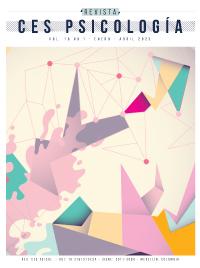El match! Escala de actitudes hacia Tinder: validez y precisión
DOI:
https://doi.org/10.21615/cesp.6448Palabras clave:
Escala de Actitudes frente a Tinder (EAFT), Tinder, actitudes, validación, aplicación de citas, sitios de redes sociales, aplicación de redResumen
Las aplicaciones de citas se utilizan como un medio para facilitar la interacción entre personas que quieren conocerse y establecer encuentros amorosos y sexuales. En este estudio pretendemos desarrollar y validar una nueva escala para medir las Actitudes hacia Tinder (EAFT). Para ello se realizaron dos estudios. En el Estudio 1 (N=260), verificamos la estructura factorial de la Escala y la distribución de ítems utilizando la Teoría de Respuesta al Ítem (TRI). Los resultados revelaron una escala breve y precisa (Cronbach de 0,95), demostrando que los ítems saturan un solo factor, contribuyendo significativamente a la formación del rasgo latente. En el Estudio 2 (N=265), buscamos confirmar la estructura unidimensional de la medida utilizando el análisis factorial confirmatorio. Los resultados mostraron buenos índices de ajuste al modelo (χ²/gl = 1,46); CFI = 1,000; TLI = 1,002; RMSEA = 0,000 (0,00 - 0,11); confirmando la estructura unifactorial encontrada en el Estudio 1. En resumen, los resultados de los dos estudios indican que la EAFT presenta buenos parámetros psicométricos, lo que la hace adecuada y confiable para medir las actitudes hacia Tinder.
Descargas
Referencias bibliográficas
Alexopoulos, C., Timmermans, E., & McNallie, J. (2020). Swiping more, committing less: Unraveling the links among dating app use, dating app success, and intention to commit infidelity. Computers in Human Behavior, 102, 172–180. https://doi.org/10.1016/j.chb.2019.08.009
Allport, G. W. (1966). Attitudes in the history of social psychology. In: Warren, N., & Jahoda, M. (Eds.). Attitudes. (p. 15-21). London: Penguin Books.
Anzani, A., Di Sarno, M., & Prunas, A. (2018). Using smartphone apps to find sexual partners: A review of the literature. Sexologies, 27(3), e61–e65. https://doi.org/10.1016/j.sexol.2018.05.001
Baker, F. B. (2001). The basics of item response theory. College Park, MD: ERIC Clearinghouse on Assessment and Evaluation. Original work published in 1985. https://www.ime.unicamp.br/~cnaber/Baker_Book.pdf
Bargh, J. A., & McKenna, K. Y. A. (2004). The internet and social life. Annual Review of Psychology, 55(1), 573–590. https://doi.org/10.1146/annurev.psych.55.090902.141922
Byrne, B. M. (2010). Structural equation modeling with amos: Basic concepts, applications, and programming. New York: Routledge.
Boyd, D. M., & Ellison, N. B. (2007). Social network sites: Definition, history, and scholarship. Journal of Computer-Mediated Communication, 13(1), 210–230. https://doi.org/10.1111/j.1083-6101.2007.00393.x
Boateng, G. O., Neilands, T. B., & Frongillo, E. A. (2018). Best practices for developing and validating scales for health, social, and behavioral research: a primer. Frontiers In Public Health, 6(149), 1–18. https://doi.org/10.3389/fpubh.2018.00149
Crites, S. L., Fabrigar, L. R., & Petty, R. E. (1994). Measuring the affective and cognitive properties of attitudes: Conceptual and methodological issues. Personality and Social Psychology Bulletin, 20(6), 619-34.
DeVellis, R. F. (2017). Scale development: theory and applications (4th ed.). Thousand Oaks, CA: Sage.
Fleck, C. (2015). Attitude: history of concept. International Encyclopedia of theSocial & Behavioral Sciences, 175–177. https://doi.org/10.1016/B978-0-08-097086-8.03146-9
Fornell, C., & Larcker, D. F. (1981). Evaluating structural equations models with unobservable variables and measurement error. Journal of Marketing, 18(1), 39-50. http://dx.doi.org/10.2307/3151312
Hahn, H. A., You, D. S., Sferra, M., Hubbard, M., Thamotharan, S., & Fields, S. A. (2018). Is it too soon to meet? Examining differences in geosocial networking app use and sexual risk behavior of emerging adults. Sexuality and Culture, 22(1), 1–21. https://doi.org/10.1007/s12119-017-9449-3
Horn, J. L. (1965), “A Rationale and test for the number of factors in factor analysis,” Psychometrika, 30, 179-85.
Happn. (2020). Happn. https://www.happn.com/en/about/
International Association of Applied Psychology [IAAP] and the International Union of Psychological Science [IUPsyS]. (2008). Universal declaration of ethical principles for psychologists. https://www.iupsys.net/about/declarations/universal-declaration-of-ethical-principles-for-psychologists/
Lorenzo-Seva, U., & Ferrando, P.J. (2013). FACTOR 9.2 A comprehensive program for fitting exploratory and semiconfirmatory factor analysis and IRT models. Applied Psychological Measurement, 37(6), 497-498. https://doi.org/10.1177/0146621613487794
Lord, F. M. (1980). Applications of item response theory to practical testing problems. Hillsdale, NJ: Lawrnce Erlbaum Associates.
March, E., Grieve, R., Marrington, J., & Jonason, P. K. (2017). Trolling on tinder® (and other dating apps): examining the role of the dark tetrad and impulsivity. Personality and Individual Differences, 110, 139–143. https://doi.org/10.1016/j.paid.2017.01.025
Merrill, R. A., & Liang, X. (2019). Associations between adolescent media use, mental health, and risky sexual behaviors. Children and Youth Services Review, 103, 1–9. https://doi.org/10.1016/j.childyouth.2019.05.022
McDonald, R. P. (1999). Test theory: A unified treatment. Mahwah, N.J.: L. Erlbaum Associates.
Morizot, J., Ainsworth, A. T., & Reise, S. P. (2007). Toward modern psychometrics: Application of item response theory models in personality research. In R. W. Robins, R. C. Fraley, & R. F. Krueger (Eds.), Handbook of Research Methods in Personality Psychology (pp. 407-423). New York: Guilford.
Muthén, L. K., & Muthén, B. O. (2010). Mplus: statistical analysis with latent variables. User’s guide (1998-2010). Los Angeles: Muthén & Muthén.
Oskamp, S., & Schultz, W. P. (2005). Attitudes and opinions. London: Laurence Erlbaum Associates, Publishers.
Neiva, E. R., & Torres, C. V. (2011). Psicologia social no Brasil: uma introdução. In C. V. Torres & E. R. Neiva (Eds.), Psicologia social: principais temas e vertentes (pp. 31-57). São Paulo: Artmed.
Orosz, G., Tóth-Király, I., Bothe, B., & Melher, D. (2016). Too many swipes for today: The development of the problematic tinder use scale (PTUS). Journal of Behavioral Addictions, 5(3), 518–523. https://doi.org/10.1556/2006.5.2016.016
Pimentel, C. E., Vilar, R., Cavalcanti, J. G., & Moura, G. B. de. (2016). Psicologia da era virtual: estrutura das atitudes frente ao Facebook. Pesquisas e Práticas Psicossociais, 11(2), 310–324.
Radovic, A., Gmelin, T., Stein, B. D., & Miller, E. (2017). Depressed adolescents’ positive and negative use of social media. Journal of Adolescence, 55, 5–15. https://doi.org/10.1016/j.adolescence.2016.12.002
Rodríguez-Castro, Y., Alonso-Ruido, P., González-Fernández, A., Lameiras-Fernández, M., & Carrera-Fernández, M. V. (2017). Spanish adolescents’ attitudes towards sexting: Validation of a scale. Computers in Human Behavior, 73, 375–384. https://doi.org/10.1016/j.chb.2017.03.049
Samejima, F. (1969). Estimation of latent ability using a response pattern of graded scores. Psychometric Monograph, 17. https://doi.org/10.1007/bf02290599
Sevi, B., Aral, T., & Eskenazi, T. (2018). Exploring the hook-up app: Low sexual disgust and high sociosexuality predict motivation to use Tinder for casual sex. Personality and Individual Differences, 133, 17–20. https://doi.org/10.1016/j.paid.2017.04.053
Ferreira, D. C. S., Pimentel, C. E., Cirino, C. S., Santos, H. S., & Oliveira, M. C. (2008). Psicologia da era virtual: atitudes de estudantes adolescentes frente ao Orkut. Psicologia Argumento, 26(55), 305-317. https://doi.org/10.7213/rpa.v26i55.19859
Sumter, S. R., Vandenbosch, L., & Ligtenberg, L. (2017). Love me tinder: Untangling emerging adults’ motivations for using the dating application Tinder. Telematics and Informatics, 34(1), 67–78. https://doi.org/10.1016/j.tele.2016.04.009
Tinsley, H. E. A., & Tinsley, D. J. (1987). Uses of factor analysis in counseling psychology research. Journal of Counseling Psychology, 34(4), 414–424. https://doi.org/10.1037/0022-0167.34.4.414
Van De Wiele, C., & Tong, S. T. (2014). Breaking boundaries: The uses & gratifications of Grindr. UbiComp 2014 - Proceedings of the 2014 ACM International Joint Conference on Pervasive and Ubiquitous Computing, 619–630. https://doi.org/10.1145/2632048.2636070
Descargas
Publicado
Cómo citar
Número
Sección
Licencia
Derechos de autor 2023 Suiane tavares, Tamyres Tomaz Paiva, Cícero Roberto Pereira, Carlos Eduardo Pimentel, Luíza Armanda Pinto dos Santos

Esta obra está bajo una licencia internacional Creative Commons Atribución-NoComercial-CompartirIgual 4.0.
Revista CES Psicología ISSN 2011 3080
Facultad de Psicología, Universidad CES Primera edición 2008. Última actualización Mayo 18 de 2022. Todos los derechos reservados. Hecho el depósito legal que exige la ley.
Se autoriza la reproducción total o parcial de los artículos citando la fuente y el autor. This publication may be reproduced by mentioning the source and the authors.
| Estadísticas de artículo | |
|---|---|
| Vistas de resúmenes | |
| Vistas de PDF | |
| Descargas de PDF | |
| Vistas de HTML | |
| Otras vistas | |




